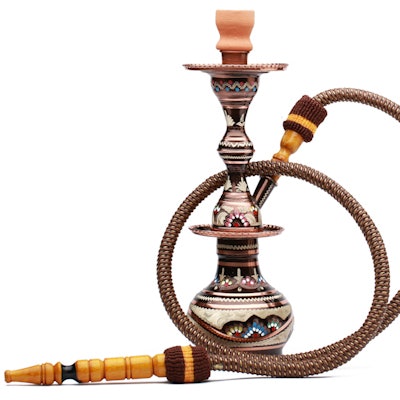
Chronic smoking of shisha or tobacco extracts from a water pipe or hookah increases cell proliferation, invasion, and migration, all of which are traits of cancer cells, according to a study published on December 28 in the Journal of Oral Pathology & Medicine.
Long-term water-pipe smoking (WPS) causes phenotypic and molecular changes in oral keratinocytes, which act as a barrier to prevent cellular injury. The findings indicate the role water-pipe smoking plays in the early onset of oral cancer, according to the authors.
"This study may serve as a useful resource in understanding the early onset of oral cancer attributed to [water-pipe] smoking," wrote the group, led by Niraj Babu of the Institute of Bioinformatics at International Technology Park in Bangalore, India.
Getting popular
Hookah smoking originated in the Middle East and parts of Asia, but its popularity has increased globally, including in the U.S.
In hookah smoking, pipes are filled with tobacco extracts or shisha. Shisha is often a mix of tobacco and fruit, mint, or molasses sugar that is processed specifically for use in water pipes. Hookah smokers may absorb more toxic substances found in cigarette smoke than cigarette smokers due to the way a water pipe is used, and they face the same risk of diseases such as esophageal and oral cancer.
In addition, an hourlong hookah smoking session often involves 200 puffs, while smoking a cigarette involves an average of 20 puffs. Individuals inhale approximately 90,000 mL of smoke during a hookah session, compared with about 600 mL when smoking a cigarette, according to the U.S. Centers for Disease Control and Prevention.
To better understand how water-pipe smoke affects cells, immortalized normal human oral keratinocytes were chronically treated with 0.1% crude tobacco and 0.5% processed shisha for eight months. Fresh tobacco extracts were added every other day, while untreated cells were maintained as a control. Cell culture‐based in vitro assays and mass spectrometry‐based quantitative proteomic analysis was used to determine any phenotypic and molecular changes. Bioinformatics was used to analyze proteomics data and locate dysregulated pathways in the cells, the authors wrote.
Cells chronically treated with shisha and crude tobacco extracts showed increased invasion, migration, and proliferation. The difference in proliferation rate could be seen 48 hours after cell seeding. At 72 and 96 hours, significant increases in cell proliferation were seen in treated cells compared to untreated cells. Additionally, cells treated with tobacco or shisha demonstrated increased cell scattering, which is associated with cancer cell-like phenotypes, according to the authors.
Furthermore, the analysis revealed an overexpression of proteins that play a role in cholesterol metabolism and vesicle-mediated transport, as well as a reduced expression of interferon signaling in those cells treated with the extracts, they wrote.
Not without limits
Study limitations included the use of only cell culture-based experiments. The findings need to be further corroborated using in vivo studies and clinical samples of water-pipe smokers, the authors noted.
Nevertheless, the "study indicates that long-term exposure to WPS leads to phenotypic and molecular changes in normal oral keratinocytes," they wrote.




















